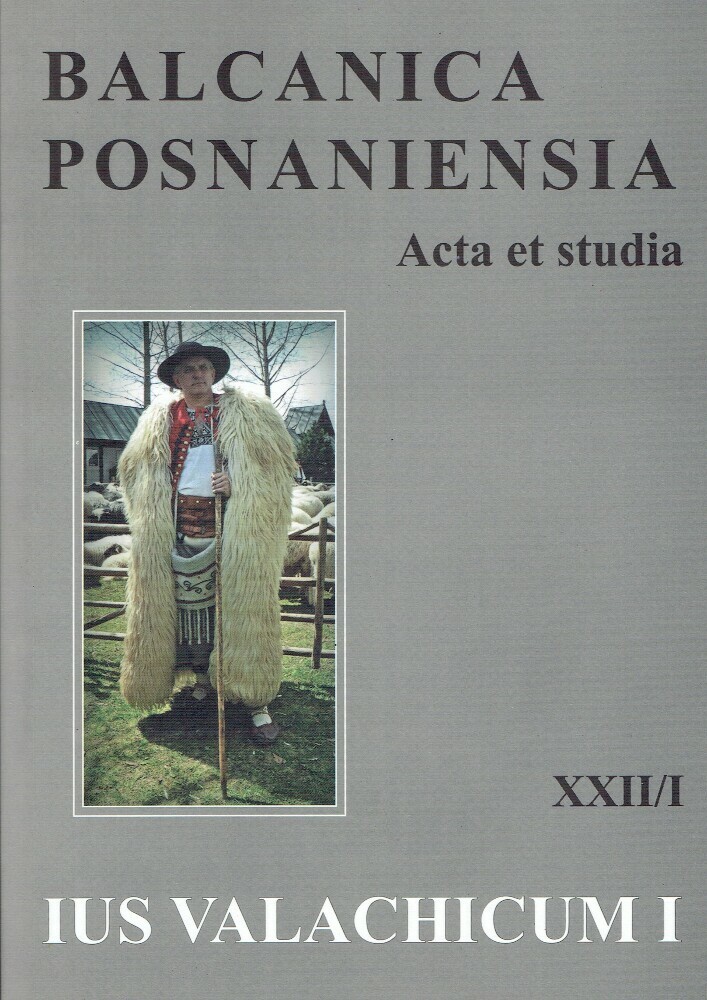Abstract
The purpose of this article is to present the relationships which occurred between the settlement of numerous villages on the Wallachian law in the mountainous regions of Medieval Poland and the influx of settlers representing the Wallachian ethnos in this area. Without doubt, both Poles and Ruthenians could not play a decisive role in this process for they did not have the essential skills related to the economic exploitation of mountains, and they were particularly not able to conduct a pastoral economy on a mass scale. They were also not able to independently adapt the forms of social organisation of villages, which were specific for the Wallachian law. The Vlachs, pouring into the studied area throughout the 14th to 16th centuries, were arguably not numerous, but they played a key role in organising new settlements in the mountains. A particularly significant role in this process was played by the chiefs of the Wallachian villages-knyazes (knezes). They had adequate knowledge, financial possibilities as well as administrative and judicial power over the rest of the people in order to become a group, which, on the one hand, was disseminating the Wallachian law, and on the other hand, was consequently standing up for the Wallachian law which was beneficial to them. Even though they relatively quickly underwent assimilation processes and integration with the local surroundings, losing their original ethnic distinctiveness, the Wallachian law was still being spread. In that way, it turned from being an ethnic law into a symbol of privileging all people who were using it, regardless of their ethnicity.
License
Copyright (c) 2015 Grzegorz Jawor

This work is licensed under a Creative Commons Attribution-NoDerivatives 4.0 International License.
- The Author hereby warrants that he/she is the owner of all the copyright and other intellectual property rights in the Work and that, within the scope of the present Agreement, the paper does not infringe the legal rights of another person.The owner of the copyright work also warrants that he/she is the sole and original creator thereof and that is not bound by any legal constraints in regard to the use or sale of the work.
- The Author grants the Purchaser non-exclusive and free of charge license to unlimited use worldwide over an unspecified period of time in the following areas of exploitation:
2.1. production of multiple copies of the Work produced according to the specific application of a given technology, including printing, reproduction of graphics through mechanical or electrical means (reprography) and digital technology;
2.2. marketing authorisation, loan or lease of the original or copies thereof;
2.3. public performance, public performance in the broadcast, video screening, media enhancements as well as broadcasting and rebroadcasting, made available to the public in such a way that members of the public may access the Work from a place and at a time individually chosen by them;
2.4. inclusion of the Work into a collective work (i.e. with a number of contributions);
2.5. inclusion of the Work in the electronic version to be offered on an electronic platform, or any other conceivable introduction of the Work in its electronic version to the Internet;
2.6. dissemination of electronic versions of the Work in its electronic version online, in a collective work or independently;
2.7. making the Work in the electronic version available to the public in such a way that members of the public may access the Work from a place and at a time individually chosen by them, in particular by making it accessible via the Internet, Intranet, Extranet;
2.8. making the Work available according to appropriate license pattern Attribution-NoDerivatives 4.0 International (CC BY-ND 4.0) as well as another language version of this license or any later version published by Creative Commons. - The Author grants the Adam Mickiewicz University in Poznan permission to:
3.1. reproduce a single copy (print or download) and royalty-free use and disposal of rights to compilations of the Work and these compilations.
3.2. send metadata files related to the Work, including to commercial and non-commercial journal-indexing databases. - The Author declares that, on the basis of the license granted in the present Agreement, the Purchaser is entitled and obliged to allow third parties to obtain further licenses (sublicenses) to the Work and to other materials, including derivatives thereof or compilations made based on or including the Work, whereas the provisions of such sub-licenses will be the same as with the attributed license pattern Attribution-NoDerivatives 4.0 International (CC BY-ND 4.0) or another language version of this license, or any later version of this license published by Creative Commons. Thereby, the Author entitles all interested parties to use the work, for non-commercial purposes only, under the following conditions:
4.1. acknowledgment of authorship, i.e. observing the obligation to provide, along with the distributed work, information about the author, title, source (link to the original Work, DOI) and of the license itself.
4.2. the derivatives of the Work are subject to the same conditions, i.e. they may be published only based on a licence which would be identical to the one granting access to the original Work. - The University of Adam Mickiewicz in Poznań is obliged to
5.1. make the Work available to the public in such a way that members of the public may access the Work from a place and at a time individually chosen by them, without any technological constraints;
5.2. appropriately inform members of the public to whom the Work is to be made available about sublicenses in such a way as to ensure that all parties are properly informed (appropriate informing messages).
Other provisions
- The University of Adam Mickiewicz in Poznań hereby preserves the copyright to the journal as a whole (layout/stylesheet, graphics, cover design, logo etc.)

